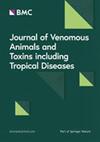贪婪,对蜇伤的反应,以及饲养母鸡吃黄蝎子(Tityus serrulatus)后的存活率
IF 1.8
3区 医学
Q4 TOXICOLOGY
Journal of Venomous Animals and Toxins Including Tropical Diseases
Pub Date : 2022-02-11
DOI:10.1590/1678-9199-JVATITD-2021-0050
引用次数: 3
摘要
背景:蝎子病是一个世界性的问题,已经造成了成千上万的受害者,多学科的方法来控制蝎子的数量是更成功的。母鸡经常被认为是控制蝎子的工具;然而,系统的/实验性的行为研究是不可用的。此外,关于蝎子毒液对母鸡的影响尚无系统的资料。本研究以毒黄蝎为研究对象,研究了母鸡的贪食性,母鸡被螫后的反应,蝎子螫伤对母鸡攻击行为的影响,以及母鸡捕食蝎子后的存活情况。方法:用玉米粉引诱母鸡,给它们喂食蝎子,记录母鸡与蝎子的相互作用。为了测试刺痛的效果,我们手动取下了蝎子的触须。结果:我们发现一些母鸡在几分钟内吃掉了六只蝎子。通过直方图和绘图,我们发现它们在捕捉蝎子时表现出几种厌恶行为。去除蝎子的触电后,老鼠的厌恶反应停止了,这在对照组中没有观察到。最后,1、7、30 d后母鸡均未表现出非典型行为,30 d后全部存活。结论:这是第一次实证和录像研究,提供了证据,母鸡明显受到蝎子毒液的影响,但不会死亡。因此,它们有可能用于这些节肢动物的生物防治。本文章由计算机程序翻译,如有差异,请以英文原文为准。
Voracity, reaction to stings, and survival of domestic hens when feeding on the yellow scorpion (Tityus serrulatus)
Abstract Background: Scorpionism is a worldwide problem that has already made thousands of victims, and multi-disciplinary approaches for controlling their populations are to be more successful. Hens are often mentioned as tools for controlling scorpions; however, systematic/experimental behavioral studies are not available. Moreover, there is no systematic information on the effect of scorpion venoms on hens. Using the venomous yellow scorpion Tityus serrulatus, the present study aimed to clarify the following aspects: (1) voracity of hens, (2) how hens react when stung, (3) the effect of scorpion stings on hen behavior during attacks, and (4) hen survivorship after feeding on scorpions. Methods: We attracted hens with corn powder, offered them scorpions and then recorded the hen-scorpion interaction. To test the effects of the sting we manually removed the scorpion’s telson. Results: We found that some hens ate up to six scorpions within minutes. By means of an ethogram and drawings, we showed that they exhibited several aversive behaviors when capturing scorpions. Removal of the scorpion telson stopped the aversive reactions, which was not observed in the control group. Finally, hens did not exhibit atypical behaviors after 1, 7 and 30 days and were all alive after 30 days. Conclusion: This is the first empirical and video recorded study providing evidence that hens are clearly affected by scorpion venom but do not die. Therefore, they may have potential to be used in biological control of these arthropods.
求助全文
通过发布文献求助,成功后即可免费获取论文全文。
去求助
来源期刊
CiteScore
4.80
自引率
8.30%
发文量
39
审稿时长
6-12 weeks
期刊介绍:
Journal of Venomous Animals and Toxins including Tropical Diseases (JVATiTD) is a non-commercial academic open access publication dedicated to research on all aspects of toxinology, venomous animals and tropical diseases. Its interdisciplinary content includes original scientific articles covering research on toxins derived from animals, plants and microorganisms. Topics of interest include, but are not limited to:systematics and morphology of venomous animals;physiology, biochemistry, pharmacology and immunology of toxins;epidemiology, clinical aspects and treatment of envenoming by different animals, plants and microorganisms;development and evaluation of antivenoms and toxin-derivative products;epidemiology, clinical aspects and treatment of tropical diseases (caused by virus, bacteria, algae, fungi and parasites) including the neglected tropical diseases (NTDs) defined by the World Health Organization.

 求助内容:
求助内容: 应助结果提醒方式:
应助结果提醒方式:


